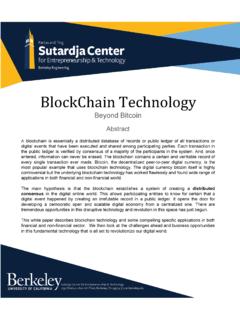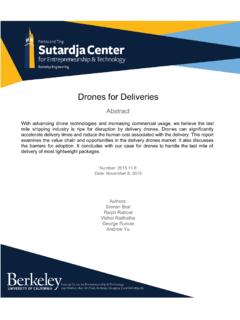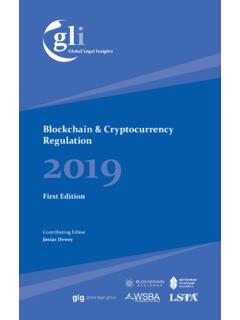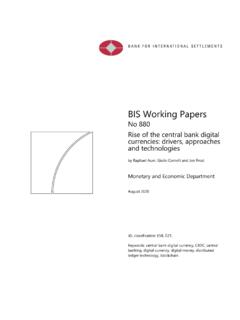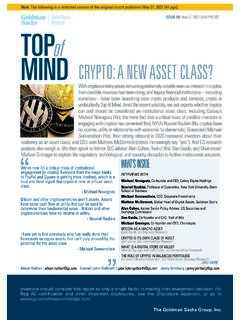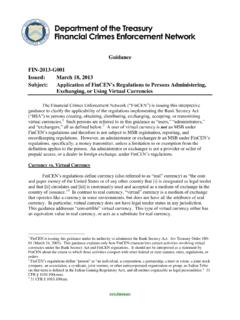Transcription of BlockChain Technology - UC Berkeley Sutardja Center
1 BlockChain Technology Beyond bitcoin Abstract Ablockchainisessentiallyadistributeddata baseofrecordsorpublicledgerofalltransact ionsor ,once entered, ,thedecentralizedpeer to peerdigitalcurrency,isthe controversialbuttheunderlyingblockchaint echnologyhasworkedflawlesslyandfoundwide rangeof applications in both financial and non financial world. Themainhypothesisisthattheblockchainesta blishesasystemofcreatinga distributed consensus digitaleventhappenedbycreatinganirrefuta blerecordinapublicledger. Itopensthedoorfor tremendous opportunities in this disruptive Technology and revolution in this space has just begun. Thiswhitepaperdescribesblockchaintechnol ogyandsomecompellingspecificapplications inboth financialandnon in this fundamental Technology that is all set to revolutionize our digital world.
2 2 Sutardja Center for Entrepreneurship & Technology Technical Report Date: October 16, 2015 Authors Michael Crosby, Google Nachiappan, Yahoo Pradhan Pattanayak, Yahoo Sanjeev Verma, Samsung Research America Vignesh Kalyanaraman, Fairchild Semiconductor Thispaperwascreatedinanopenclassroomenvi ronmentaspartofaprogramwithintheSutardja Centerfor Entrepreneurship& University of California Berkeley . 2 3 Sutardja Center for Entrepreneurship & Technology Technical Report Introduction A BlockChain is essentially a distributed database of records or public ledger of all transactions or digital events that have been executed and shared among participating parties. Each transaction in the public ledger is verified by consensus of a majority of the participants in the system. And, once entered, information can never be erased. The BlockChain contains a certain and verifiable record of every single transaction ever made.
3 To use a basic analogy, it is easy to steal a cookie from a cookie jar, kept in a secluded place than stealing the cookie from a cookie jar kept in a market place, being observed by thousands of people. bitcoin is the most popular example that is intrinsically tied to BlockChain Technology . It is also the most controversial one since it helps to enable a multibillion-dollar global market of anonymous transactions without any governmental control. Hence it has to deal with a number of regulatory issues involving national governments and financial institutions. However, BlockChain Technology itself is non-controversial and has worked flawlessly over the years and is being successfully applied to both financial and non-financial world applications. Last year, Marc Andreessen, the doyen of Silicon Valley s capitalists, listed the BlockChain distributed consensus model as the most important invention since the Internet itself. Johann Palychata from BNP Paribas wrote in the Quintessence magazine that bitcoin s BlockChain , the software that allows the digital currency to function should be considered as an invention like the steam or combustion engine that has the potential to transform the world of finance and beyond.
4 Current digital economy is based on the reliance on a certain trusted authority. Our all online transactions rely on trusting someone to tell us the truth it can be an email service provider telling us that our email has been delivered; it can be a certification authority telling us that a certain digital certificate is trustworthy; or it can be a social network such as Facebook telling us that our posts regarding our life events have been shared only with our friends or it can be a bank telling us that our money has been delivered reliably to our dear ones in a remote country. The fact is that we live our life precariously in the digital world by relying on a third entity for the security and privacy of our digital assets. The fact remains that these third party sources can be hacked, manipulated or compromised. This is where the BlockChain Technology comes handy. It has the potential to revolutionize the digital world by enabling a distributed consensus where each and every online transaction, past and present, involving digital assets can be verified at any time in the future.
5 It does this without compromising the privacy of the digital assets and parties involved. The distributed consensus and anonymity are two important characteristics of BlockChain Technology . 3 4 Sutardja Center for Entrepreneurship & Technology Technical Report The advantages of BlockChain Technology outweigh the regulatory issues and technical challenges. One key emerging use case of BlockChain Technology involves smart contracts . Smart contracts are basically computer programs that can automatically execute the terms of a contract. When a pre-configured condition in a smart contract among participating entities is met then the parties involved in a contractual agreement can be automatically made payments as per the contract in a transparent manner. Smart Property is another related concept which is regarding controlling the ownership of a property or asset via BlockChain using Smart Contracts. The property can be physical such as car, house, smartphone etc.
6 Or it can be non-physical such as shares of a company. It should be noted here that even bitcoin is not really a currency -- bitcoin is all about controlling the ownership of money. BlockChain Technology is finding applications in wide range of areas both financial and non-financial . Financial institutions and banks no longer see BlockChain Technology as threat to traditional business models. The world s biggest banks are in fact looking for opportunities in this area by doing research on innovative BlockChain applications. In a recent interview Rain Lohmus of Estonia s LHV bank told that they found BlockChain to be the most tested and secure for some banking and finance related applications. Non-Financial applications opportunities are also endless. We can envision putting proof of existence of all legal documents, health records, and loyalty payments in the music industry, notary, private securities and marriage licenses in the BlockChain .
7 By storing the fingerprint of the digital asset instead of storing the digital asset itself, the anonymity or privacy objective can be achieved. In this report, we focus on the disruption that every industry in today s digital economy is facing today due to the emergence of BlockChain Technology . BlockChain Technology has potential to become the new engine of growth in digital economy where we are increasingly using Internet to conduct digital commerce and share our personal data and life events. There are tremendous opportunities in this space and the revolution in this space has just begun. In this report we focus on few key applications of BlockChain Technology in the area of Notary, Insurance, private securities and few other interesting non-financial applications. We begin by first describing some history and the Technology itself . Section I: BlockChain Technology History of bitcoin 4 5 Sutardja Center for Entrepreneurship & Technology Technical Report In year 2008, an individual or group writing under the name of Satoshi Nakamoto published a paper entitled bitcoin : A Peer-To-Peer Electronic Cash System.
8 This paper described a peer-to-peer version of the electronic cash that would allow online payments to be sent directly from one party to another without going through a financial institution. bitcoin was the first realization of this concept. Now word cryptocurrencies is the label that is used to describe all networks and mediums of exchange that uses cryptography to secure transactions-as against those systems where the transactions are channeled through a centralized trusted entity. The author of the first paper wanted to remain anonymous and hence no one knows Satoshi Nakamoto to this day. A few months later, an open source program implementing the new protocol was released that began with the Genesis block of 50 coins. Anyone can install this open source program and become part of the bitcoin peer-to-peer network. It has grown in popularity since then. 2008 August 18 Domain name " " registered October 31 bitcoin design paper published November 09 bitcoin project registered at 2009 January 3 Genesis block established at 18:15:05 GMT January 9 bitcoin released and announced on the cryptography mailing list January 12 First bitcoin transaction, in block 170 from Satoshi to Hal Finney The popularity of the bitcoin has never ceased to increase since then.
9 The underlying BlockChain Technology is now finding new range of applications beyond finance. Technology : How does it work? We explain the concept of the BlockChain by explaining how bitcoin works since it is intrinsically linked to the bitcoin . However, the BlockChain Technology is applicable to any digital asset transaction exchanged online. 5 6 Sutardja Center for Entrepreneurship & Technology Technical Report Figure 1. Traditional online financial transactions using third trusted party ( Banks, Paypal etc.). 1 Internet commerce is exclusively tied to the financial institutions serving as the trusted third party who process and mediate any electronic transaction. The role of trusted third party is to validate, safeguard and preserve transactions. A certain percentage of fraud is unavoidable in online transactions and that needs mediation by financial transactions.
10 This results in high transaction costs. bitcoin uses cryptographic proof instead of the trust in the third party for two willing parties to execute an online transaction over the Internet. Each transaction is protected through a digital signature. Each transaction is sent to the public key of the receiver digitally signed using the private key of the sender. In order to spend money, owner of the cryptocurrency needs to prove the ownership of the private key . The entity receiving the digital currency verifies the digital signature thus ownership of corresponding private key --on the transaction using the public key of the sender. Each transaction is broadcast to every node in the bitcoin network and is then recorded in a public ledger after verification. Every single transaction needs to be verified for validity 1 6 7 Sutardja Center for Entrepreneurship & Technology Technical Report before it is recorded in the public ledger.
